
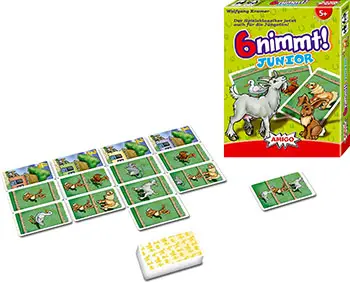
Components
- 52 animal cards
- 42 showing one animal each
- 6 showing two animals
- 4 showing three animals
- 4 stable cards
- Instructions
Object of the Game
For the moment, the sun is still shining in the blue sky over the little animal farm. But in the distance, dark thunderclouds can already be made out.
The ponies, goats, rabbits, ducks, chickens and even the little mice are looking for shelter from the storm in the stables.
The players help the animals find space in there. If you can shelter six different animals in one stable, you may take the cards in your care.
The player who owns the most animals wins the game.
Setup
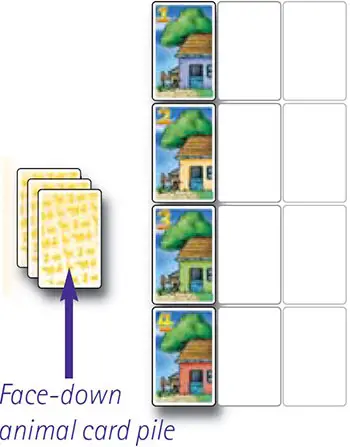
Place the four stable cards underneath each other in the center of the table.
Each stable card is the beginning of a row.
Shuffle the animal cards and put then next to the stable cards in a face-down draw pile (see illustration).
Game Play
Turns are taken clockwise. The player whose turn it is draws the top card from the draw pile and places it face- up in one of the four rows. The drawn card is always added to the right end of the chosen row.
Then it's the next player's turn.
When adding a card to a row, the following four rules have to be followed:
An animal can only be placed in a row where the same animal hasn't already been placed.
If an animal already appears in all four rows the player can choose which row he or she wants to place the card in.
If the drawn card shows more than one animal, it can only be placed in a row where at least one of the animals hasn't been placed yet. The other animals on the card may already be present in the row.
If all animals on the card already appear in all rows, the player can choose which row he or she wants to place the card in.A row (or a stable) is full when each of the six animals appears at least once in it. The player who places the final card to fill the row gets all animal cards from that row, including the one that has been played last.
There can be more or fewer than six cards in one row. The stable card always remains on the table.
The player who has won the animal cards puts them in a little pile in front of him- or herself. The empty row can now be re-filled with animal cards. At any point during the game, there are always four rows in which to place cards.
Some Examples:
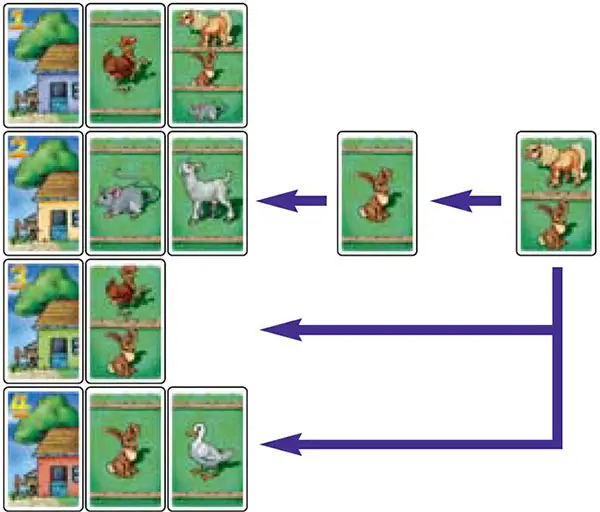
The rabbit can only be placed in the second row, as rabbits appear in all other rows already.
The card "pony and rabbit" can then be placed in the second, third or fourth row, as the pony does not appear in any of these rows yet.
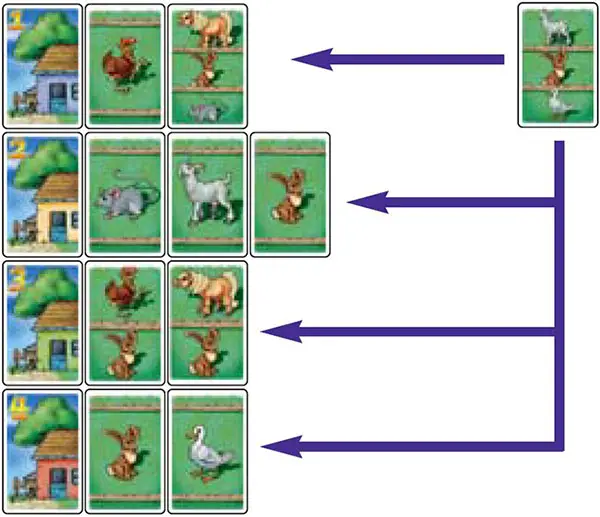
The card "goat with rabbit and duck" may be placed in any row, because it adds at least one new animal to each of the four rows.
If the card is placed in the first row, the row is full (six different animals) and the player gets the three cards.
End of the Game
The game ends as soon as the bottom card from the draw pile is placed in a row. Now, all players count the cards in their little piles. The player with the most cards is the winner.
Players who can't count yet can put all their cards in a row. The player with the longest row is the winner.
Variant: No-one wants an animal card
All rules remain the same. However, players now have to try and avoid collecting animal cards. They will only add the sixth kind of animal to a row, and so fill it, if there is really no other way.
The player who has the fewest cards at the end of the game is the winner.
Variant: All play at the same time
In this variant the numbers on the stable cards become important. The card showing the number 1 becomes the start of the first row, the card with the number 2 on it starts the second card and so on.
Unlike in the usual game, the rows are now arranged in a star shape in the center of the table (see illustration on the right).
The player whose turn it is turns over the top card of the draw pile and puts it on top of the draw pile face-up, so that all players can see it.
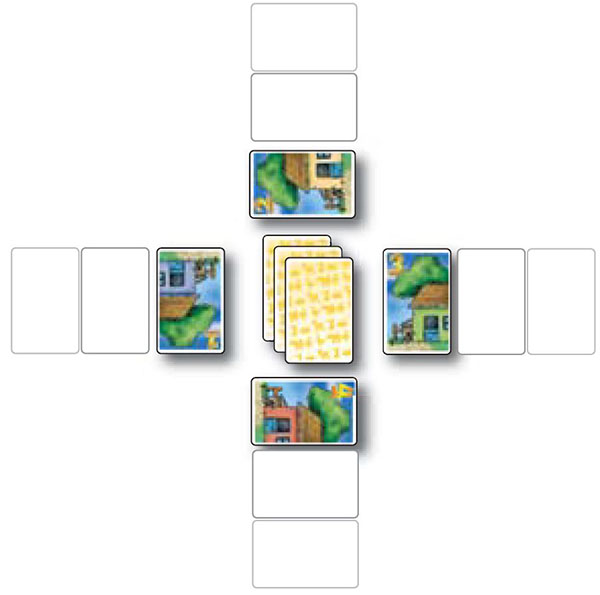
All players now try to figure out if this card can be placed in a row so that it contains all six kinds of animals.
If this is not possible, the player whose turn it is places the card in one of the rows according to the rules above.
If it is possible, though, the first player who has noticed it calls out "six takes all" and grabs the stable card for that row. All players check immediately if this row (together with the drawn card) really shows six different types of animals.
If the player has called it correctly, he or she gets all the animal cards from this row, including the turned- over card.
If the player was wrong, he or she has to pay one card from his or her pile, if he or she already possesses any cards.
The player who has turned over the card in the first place takes this card an places it in one of the four rows according to the rules above.
In both cases, the stable card the player has grabbed is returned to its place at the start of the row.
If two or more players call out "six takes all" and grab different stable cards, each of these rows will have to be checked.
If several players have called out correctly, they each get the cards from the rows for which they hold the number card.
A player who has called out incorrectly has to pay one card from his or her pile, if he or she already possesses any cards.
No player gets the turned-over animal card. Instead, the player whose turn it is places it in one of the rows according to the rules above.
All stable cards that have been grabbed by the players are returned to their places at the start of the rows.
Continue Reading


